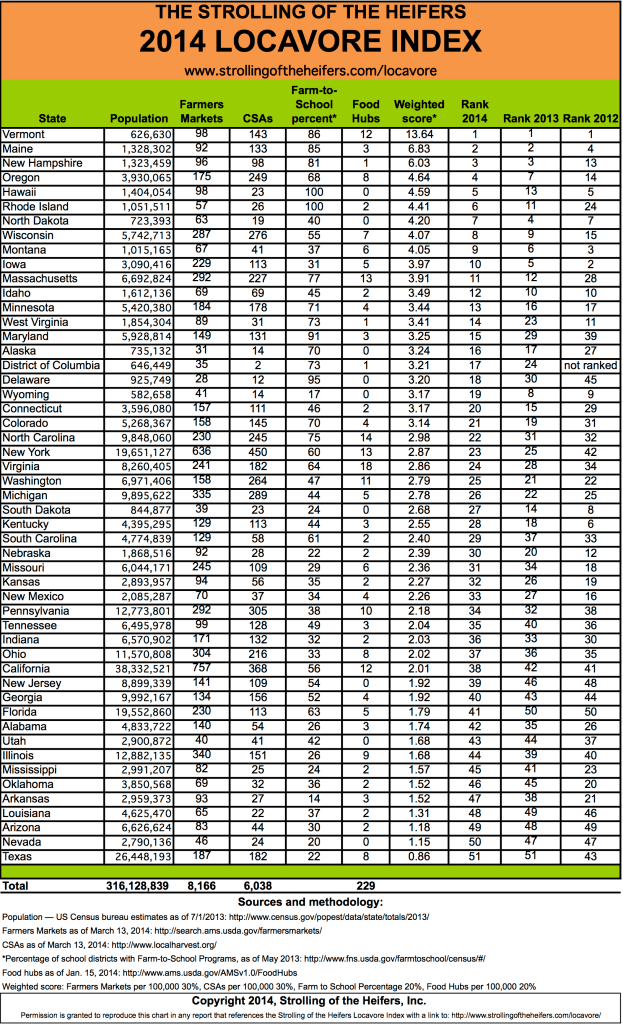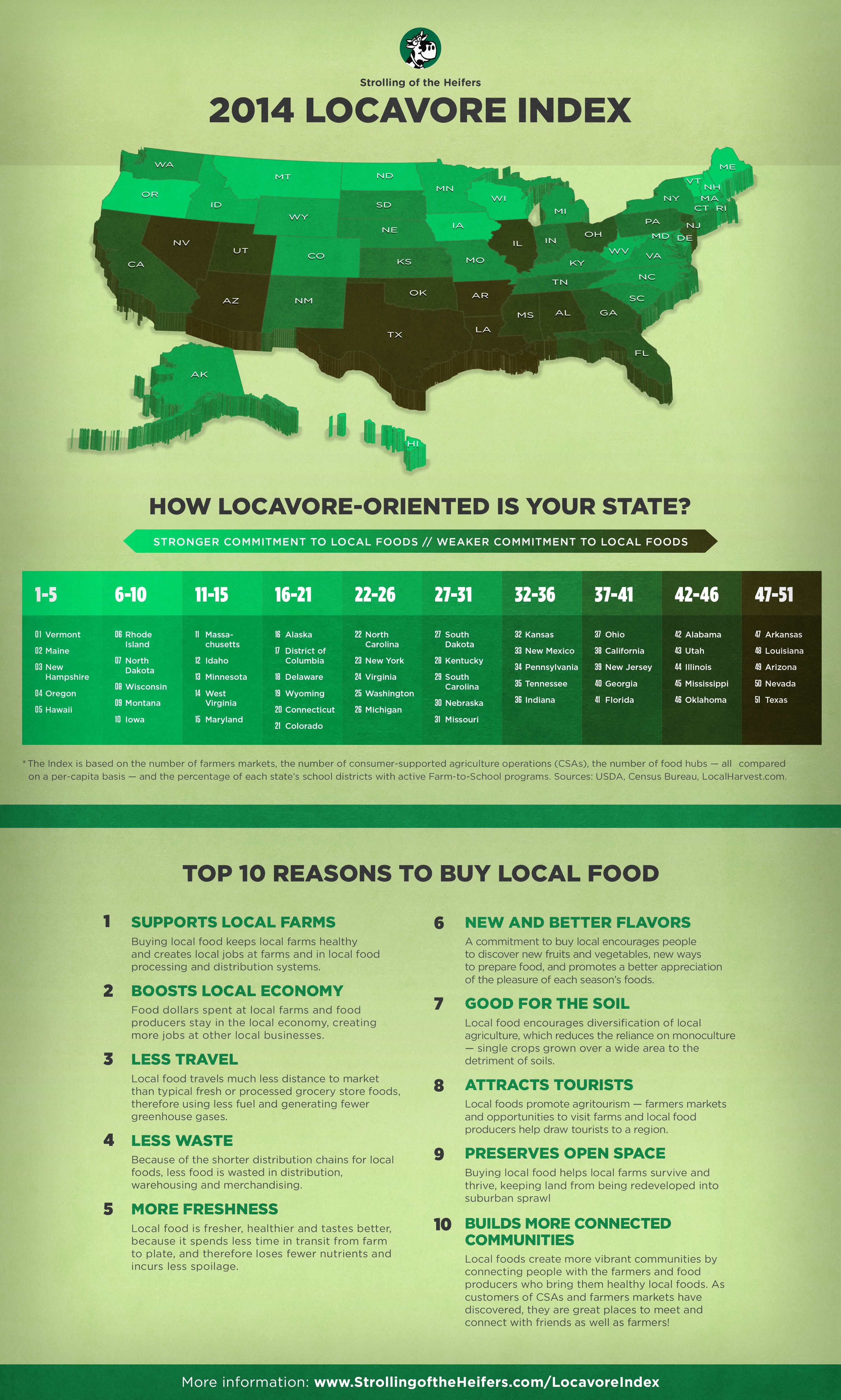BRATTLEBORO, VT (April 7, 2014)— Strolling of the Heifers, a Vermont-based local food advocacy group, has released its third annual Locavore Index, a state-by-state ranking of commitment to local foods.
By compiling the Index, Strolling of the Heifers hopes to strengthen local farms and food systems by encouraging efforts across the country to increase the use of local foods in homes, restaurants, schools and institutions.
The 2014 Locavore Index incorporates four measures for which current data is available for all states: the number of farmers markets, the number of consumer-supported agriculture operations (CSAs), the number of food hubs — all compared on a per-capita basis — plus the percentage of each state’s school districts with active Farm-to-School programs. But more data on local foods should be gathered, Strolling of the Heifers says.
Click on the image above to open an new window and then click on the image again to enlarge
“For all the attention that locavorism has received in recent years, reliable and consistent state-by-state statistics on local food consumption are hard to come by,” said Orly Munzing, founder and executive director of Strolling of the Heifers “If we all agree that growing, buying and eating local foods is good, then we need to do a better job of measuring it,” Munzing said.
The Index says the top three states for locavorism, are (in order) Vermont, Maine and New Hampshire, rankings that are unchanged from last year. Oregon moved up to fourth place (from seventh in 2013), and Hawaii came in fifth (from 13th in 2013). Rounding out the top 10 were Rhode Island, North Dakota, Wisconsin, Montana and Iowa.
“This ranking reflects the commitment Vermonters have made to community based agriculture,” said Chuck Ross, Vermont’s Secretary of Agriculture, Food and Markets. “From the farm and food system entrepreneurs who are providing local foods, to the schools and institutions that are stepping up to integrate local foods, to the individual Vermonters who are making healthy, local choices, our state has embraced a systems approach to agriculture.”
Along with the Index, Strolling of the Heifers released its list of 10 reasons to increase the use of local foods, stressing that local foods are more sustainable, healthier, better for the environment and economically positive than foods sourced from large-scale, globalized food systems.
Strolling of the Heifers’ 10 reasons to consume local foods:
- Supports local farms: Buying local food keeps local farms healthy and creates local jobs at farms and in local food processing and distribution systems.
- Boosts local economy: Food dollars spent at local farms and food producers stay in the local economy, creating more jobs at other local businesses.
- Less travel: Local food travels much less distance to market than typical fresh or processed grocery store foods, therefore using less fuel and generating fewer greenhouse gases.
- Less waste: Because of the shorter distribution chains for local foods, less food is wasted in distribution, warehousing and merchandising.
- More freshness: Local food is fresher, healthier and tastes better, because it spends less time in transit from farm to plate, and therefore loses fewer nutrients and incurs less spoilage.
- New and better flavors: A commitment to buy local encourages people to discover new fruits and vegetables, new ways to prepare food, and promotes a better appreciation of the pleasure of each season’s foods.
- Good for the soil: Local food encourages diversification of local agriculture, which reduces the reliance on monoculture — single crops grown over a wide area to the detriment of soils.
- Attracts tourists: Local foods promote agritourism — farmers markets and opportunities to visit farms and local food producers help draw tourists to a region.
- Preserves open space: Buying local food helps local farms survive and thrive, keeping land from being redeveloped into suburban sprawl.
- Builds more connected communities: Local foods create more vibrant communities by connecting people with the farmers and food producers who bring them healthy local foods. As customers of CSAs and farmers markets have discovered, they are great places to meet and connect with friends as well as farmers!
The Components of the Index are:
- Farmers markets, which are generally cooperative efforts to market locally produced food in a central location where consumers can select and purchase food from multiple farm enterprises.
- CSAs (consumer-supported agriculture), which are cooperative agreements between farmers and consumers; consumers buy shares in a farm’s output, and have some say in what is grown. When crops come in, they are divided among shareholders according to the volume of their shares, and the rest may be sold at market. CSA farmers get revenue in advance to cover costs of tilling, soil preparation and seed. Shareholders get fresh produce grown locally and contribute to sustainable farming practices.
- Farm-to-School programs, in which schools buy and feature locally produced, farm-fresh foods. Participating schools usually also add nutrition, culinary and food science components to their curriculum, and may experiential learning opportunities such as farm visits, school gardens and composting.
- Food hubs, which are facilities that handle the aggregation, distribution and marketing of foods from a group of farms and food producers in a region. Food hubs are often cooperatively owned, though many are private enterprises.
Sources for the data used in the Index includes three U.S. Department of Agriculture databases: farmers markets (updated monthly), food hubs, and the Farm-to-School Census; the U.S. Census bureau (July 2012 estimates of population); and the California-based local food resource directory LocalHarvest, a frequently-updated database of CSAs. Here is the complete data grid used in compiling the Index.
 Click on the image above to open an new window and then click on the image again to enlarge
Click on the image above to open an new window and then click on the image again to enlarge
About Strolling of the Heifers:
Strolling of the Heifers has been celebrating local farmers and local food since 2002, most visibly through its agriculturally-themed Strolling of the Heifers Parade, which takes place on June 7 in Brattleboro, Vt. as part of a full weekend of events. The parade features scores of well-groomed heifer calves led by future farmers, and is followed by an all-day festival, the Slow Living Expo, with food, entertainment and educational exhibits. “Stroll Weekend” is preceded by the Slow Living Summit, a conference focused on connected, resilient communities and sustainable living, which brings together concerned citizens from many organizations and sectors to explore and network around “slower” — more sustainable — approaches to many aspects of living ranging from food and agriculture to health and wellness. The Slow Living Summit takes place in downtown Brattleboro, June 4-6. One the web:www.StrollingoftheHeifers.com, www.SlowLivingSummit.org.
For further information about the Index, please contact Martin Langeveld, Strolling of the Heifers —[email protected]
The 2014 Strolling of the Heifers Locavore Index state rankings are: (The number in parentheses is the 2013 rank.)
- Vermont (1)
- Maine (2)
- New Hampshire (3)
- Oregon (7)
- Hawaii (13)
- Rhode Island (11)
- North Dakota (4)
- Wisconsin (9)
- Montana (6)
- Iowa (5)
- Massachusetts (12)
- Idaho (10)
- Minnesota (16)
- West Virginia (23)
- Maryland (29)
- Alaska (17)
- District of Columbia (24)
- Delaware (30)
- Wyoming (8)
- Connecticut (15)
- Colorado (19)
- North Carolina (31)
- New York (25)
- Virginia (28)
- Washington (21)
- Michigan (22)
- South Dakota (14)
- Kentucky (18)
- South Carolina (37)
- Nebraska (20)
- Missouri (34)
- Kansas (26)
- New Mexico (27)
- Pennsylvania (32)
- Tennessee (40)
- Indiana (33)
- Ohio (36)
- California (42)
- New Jersey (46)
- Georgia (43)
- Florida (50)
- Alabama (35)
- Utah (44)
- Illinois (39)
- Mississippi (41)
- Oklahoma (45)
- Arkansas (38)
- Louisiana (49)
- Arizona (48)
- Nevada (47)
- Texas (51)


